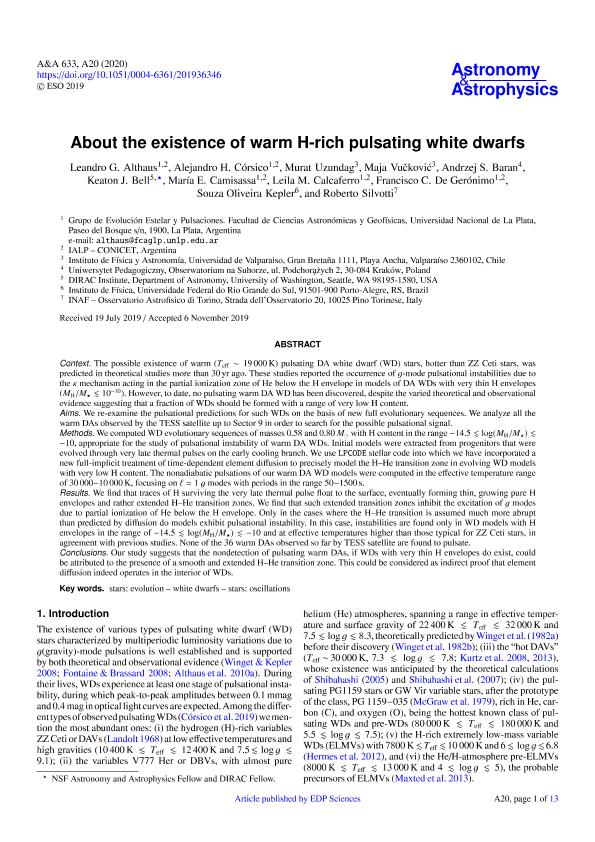Artículo
About the existence of warm H-rich pulsating white dwarfs
Althaus, Leandro Gabriel ; Corsico, Alejandro Hugo
; Corsico, Alejandro Hugo ; Uzundag, Murat; Vucković, Maja; Baran, Andrzej S.; Bell, Keaton J.; Camisassa, María Eugenia
; Uzundag, Murat; Vucković, Maja; Baran, Andrzej S.; Bell, Keaton J.; Camisassa, María Eugenia ; Calcaferro, Leila Magdalena
; Calcaferro, Leila Magdalena ; de Gerónimo, Francisco César
; de Gerónimo, Francisco César ; Kepler, Souza Oliveira; Silvotti, Roberto
; Kepler, Souza Oliveira; Silvotti, Roberto
 ; Corsico, Alejandro Hugo
; Corsico, Alejandro Hugo ; Uzundag, Murat; Vucković, Maja; Baran, Andrzej S.; Bell, Keaton J.; Camisassa, María Eugenia
; Uzundag, Murat; Vucković, Maja; Baran, Andrzej S.; Bell, Keaton J.; Camisassa, María Eugenia ; Calcaferro, Leila Magdalena
; Calcaferro, Leila Magdalena ; de Gerónimo, Francisco César
; de Gerónimo, Francisco César ; Kepler, Souza Oliveira; Silvotti, Roberto
; Kepler, Souza Oliveira; Silvotti, Roberto
Fecha de publicación:
01/2020
Editorial:
EDP Sciences
Revista:
Astronomy and Astrophysics
ISSN:
0004-6361
Idioma:
Inglés
Tipo de recurso:
Artículo publicado
Clasificación temática:
Resumen
Context. The possible existence of warm (Teff ∼ 19 000 K) pulsating DA white dwarf (WD) stars, hotter than ZZ Ceti stars, was predicted in theoretical studies more than 30 yr ago. These studies reported the occurrence of g-mode pulsational instabilities due to the κ mechanism acting in the partial ionization zone of He below the H envelope in models of DA WDs with very thin H envelopes (MH/M⋆ ≲ 10-10). However, to date, no pulsating warm DA WD has been discovered, despite the varied theoretical and observational evidence suggesting that a fraction of WDs should be formed with a range of very low H content. Aims: We re-examine the pulsational predictions for such WDs on the basis of new full evolutionary sequences. We analyze all the warm DAs observed by the TESS satellite up to Sector 9 in order to search for the possible pulsational signal. Methods: We computed WD evolutionary sequences of masses 0.58 and 0.80 M☉ with H content in the range -14.5 ≲ log(MH/M⋆)≲ - 10, appropriate for the study of pulsational instability of warm DA WDs. Initial models were extracted from progenitors that were evolved through very late thermal pulses on the early cooling branch. We use LPCODE stellar code into which we have incorporated a new full-implicit treatment of time-dependent element diffusion to precisely model the H-He transition zone in evolving WD models with very low H content. The nonadiabatic pulsations of our warm DA WD models were computed in the effective temperature range of 30 000 - 10 000 K, focusing on ℓ = 1 g modes with periods in the range 50 - 1500 s. Results: We find that traces of H surviving the very late thermal pulse float to the surface, eventually forming thin, growing pure H envelopes and rather extended H-He transition zones. We find that such extended transition zones inhibit the excitation of g modes due to partial ionization of He below the H envelope. Only in the cases where the H-He transition is assumed much more abrupt than predicted by diffusion do models exhibit pulsational instability. In this case, instabilities are found only in WD models with H envelopes in the range of -14.5 ≲ log(MH/M⋆)≲ - 10 and at effective temperatures higher than those typical for ZZ Ceti stars, in agreement with previous studies. None of the 36 warm DAs observed so far by TESS satellite are found to pulsate. Conclusions: Our study suggests that the nondetection of pulsating warm DAs, if WDs with very thin H envelopes do exist, could be attributed to the presence of a smooth and extended H-He transition zone. This could be considered as indirect proof that element diffusion indeed operates in the interior of WDs.
Palabras clave:
stars: evolution
,
white dwarfs
,
stars: oscillations
Archivos asociados
Licencia
Identificadores
Colecciones
Articulos(IALP)
Articulos de INST.DE ASTROFISICA LA PLATA
Articulos de INST.DE ASTROFISICA LA PLATA
Citación
Althaus, Leandro Gabriel; Corsico, Alejandro Hugo; Uzundag, Murat; Vucković, Maja; Baran, Andrzej S.; et al.; About the existence of warm H-rich pulsating white dwarfs; EDP Sciences; Astronomy and Astrophysics; 633; A20; 1-2020; 1-13
Compartir
Altmétricas



